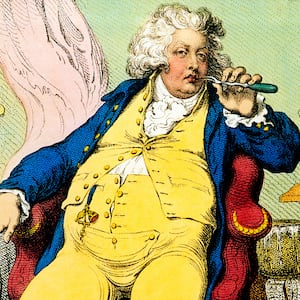In today’s sudden age of social distancing, an antique jewel—meant to remind estranged lovers of each other—could be the perfect symbol of how to combat the loneliness of these strange times.
The Lover’s Eye, as it’s appropriately called, was all the rage in early 19th-century Europe: a small brooch that depicted the beautiful eye of a secret admirer. The brooches served as stand-ins when the lovestruck could not physically be together.

Photographed at the Metropolitan Museum of Art
Photo courtesy of @Levi_HiggsThe origin of the Lover’s Eye jewel comes out of forbidden romance. In 1784, the Prince of Wales, George Augustus Frederick—later King George IV—had fallen in love with a twice-widowed commoner named Maria Fitzherbert at an opera. But the most difficult aspect of the match was that she was, unfortunately for the Protestant king, a Catholic.
ADVERTISEMENT
Forbidden to wed by British law, the two had a secret marriage and exchanged portrait miniatures of each other’s eyes as a token of their love. Of course, the hand-painted eyes kept the identity of the loved one a secret from the masses. For the next 30 years, until around 1820, the trend for Lover’s Eye jewels was in full swing.
The Lover’s Eye was “the younger sibling of portrait miniatures,” says Elle Shushan, an author, lecturer and portrait miniature specialist dealer, referring to the traditional craft of tiny, hand-painted images of loved ones. “By the mid-18th century, portrait miniatures had been around for 300 years. Eyes were simply a novel new way of having a portable portrait. The first finite record I've found of one in Britain is early 1770s—15 years before the eyes of Mrs. Fitzherbert and the Prince. They started the fad—but not the tradition.”

Eye of Mary Sarah Fox in Foxgloves English School c. 1830
Courtesy Elle ShushanPortrait miniatures were often painted with single-hair brushes, with hand-mixed pigments on ivory or animal skin canvas. When this craft strayed into the realm of jewelry, they could become pendants, rings, or brooches, and be hidden in lockets or bracelets. Often, they were very heavily bejeweled, depending upon the depth of the purse of the purchaser.
For Lover’s Eyes specifically, rather than depicting the entire sitter, the image was only of the eye—sometimes both, but often only one. A clue to the beloved’s identity might be glimpsed by the curly brown hair cascading down the side of the frame, or indeed from the very eye color itself. Often, the identity of the eye was a tightly guarded secret between giver and wearer. They could be having an affair, or the match might not be sanctioned by the family or the law. Some Lover’s Eyes are seen peering out from behind ivy or bunches of flowers, adding another layer of symbolism, as the language of flowers was one with deep emotional connection, as well.
At the time that Lover’s Eyes first emerged in England, mainland Europe, and (rarely) in America, wars separated lovers, plagues decimated cities and armies, and merchants and adventurers spent years away from home on the far side of the world.
The Lover’s Eye jewel was a way of keeping the idea of the person you cared for most close, as well as keeping their identity known only to you. These jewels could be embellished with gemstones, gold, and other finery. If the person depicted had passed away, the portrait of the eye might be surrounded with pearls, to symbolize tears. Sometimes the eye itself would be painted with a single tear emerging from the duct, either made with paint or sometimes even an inset diamond. Gemstones sometimes surrounded the eye, or paste (an early sort of rhinestone), or coral, or gold with enamel. The Victorians were obsessed with the Ouroboros, a snake eating its own tail that symbolized (among other things) eternal love, as popularized by Queen Victoria. This motif is often used surrounding the eye as well.

Now, centuries later, contemporary jewelers are starting to again be inspired by Lover’s Eyes. David Michael Jewels is a design duo of twin brothers working on the Gold Coast of Australia to hand-make one-of-a-kind jewels for a select clientele. Michael, one of the brothers, is inspired by the classical techniques of jewelry-making and has taught himself many different types of crafting from videos online and jewelry books. A few of their jewels feature painted miniatures, like a Koi Pond Brooch that sold at Sotheby’s last year for $60,000. The koi fish was hand-painted onto a mother of pearl backing, and had an aquamarine stone set over the top of it, to give the appearance of water over the fish, in the pond.
Michael has also been known to thank his friends with specially painted renderings of jewels he would like to make one day—including Lover’s Eyes. Oftentimes the painted eye can be of a human partner, or of an animal companion. Some people have commissioned jewels made to commemorate their beloved pets, with a hand-painted cat or dog’s eye in the center of a portrait-cut diamond.

Michael says that “designing a jewel is like writing a story, every character should have its place. Rich layers of detail make for a more interesting read, and it’s the same for jewellery, too. The more meaning you can add to a sentimental piece, the greater story it tells. We use gems and silhouettes to add symbolism that in most cases only the owner will be able to understand. Gems, shapes and colors become just as powerful as words.”
When asked about what makes these sorts of contemporary jewels relevant in the midst of a global pandemic, Michael says, “For me it’s the human element that makes an item truly special. There’s no greater representation of a human than a portrait, and eyes are what we look at while communicating with each other, so Lover’s Eyes are the most pure representation of us as human and our love for each other. This human aspect offers so much deeper value than the sum of its parts. I think these times make people think about what’s really important; human connections and relationships.”

Of course, Lover’s Eyes are not the only type of jewelry that arose to meet the cultural needs of unprecedented and difficult times. In the 1940s, when platinum was needed for the war effort, all the glittering white Art Deco jewelry of the 1920s and ’30s transformed basically overnight to rose gold and yellow gold tones—now known as “Retro” style jewels. It’s interesting to think of jewelry as reactionary to the times we live in, but every form of decorative art adapts when needed. Fashions change abruptly, new materials emerge—and even a simple brooch can start to convey more meaning that it ever had before.






